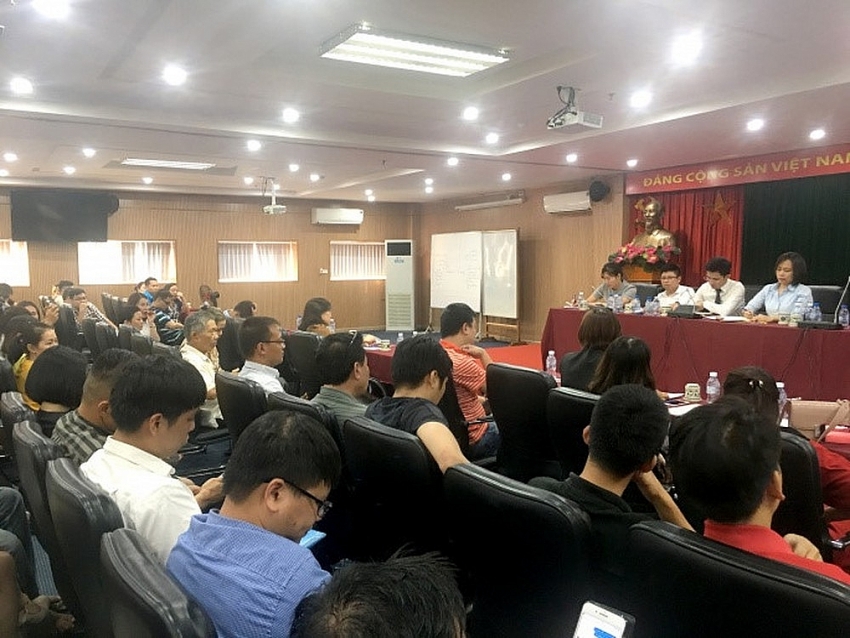What is behind PVcomBank’s seizure of Tokyu Tower?
 |
| The meeting between PVcomBank and apartment buyers at Tokyu Tower |
Few days ago, Vietnam People's Bank (PVcomBank) seized Tokyu Tower, a secured asset, to handle the financial obligations of the project developer Song Da 1.01 JSC and its exclusive distributor Hoang Vuong Trading JSC.
According to PVcomBank, all remaining assets of the project have been seized, including the right to collect from apartment sales contracts and the trading centre floor, the apartments, and commercial center floor that have not yet been sold or leased.
At the same time, PVcomBank also seized all property rights arising from the apartment purchase and sales contracts between Hoang Vuong Trading Company and Song Da 1.01 Joint Stock Company.
Tokyu Tower is a multi-purpose building and high-end apartment complex with 51 storeys, including five floors for a commercial centre.
During project implementation, the project developer Song Da 1.01 Joint Stock Company and its exclusive distributor Hoang Vuong Trading JSC had defaulted on debts to PVcomBank, which they secured by Tokyu Tower.
According to PVcomBank, the original debt of Song Da 1.01 JSC and Hoang Vuong JSC totalled nearly VND600 billion ($26.5 million).
| A PVcomBank representative said that they will select a suitable investor to resume the project and ensure the legitimate rights of apartment buyers following the signed contracts. |
At a recent meeting with buyers at the project, Mai Xuan Thuong, director of Assets Management at PVcomBank said the assets seized by the bank at Tokyu Tower were not the assets that the customers had bought from the project developer.
Therefore, the buyers still hold ownership rights as prescribed by law.
However, given the fact that the developer now has no capacity to further implement the project, the best option would be for PVcomBank to select a new investor to resume the construction and finish the project to handover the apartments to buyers.
A PVcomBank representative said that they will select a suitable investor to resume the project and ensure the legitimate rights of apartment buyers following the signed contracts.
The source also confirmed that the bank and the new investor will keep in touch with apartment buyers until the project is finished and expect the right attitude from buyers to find the best remedy together, allowing customers to soon receive their apartments.
To tackle the impediments from the project’s delay, PVcombank said that they will offer support to customers who took up loans at the bank to buy apartments at Tokyu Tower by providing exemption or reduction of late payment penalties.
The policy on the reduction/exemption of late payment penalties will follow current legislation and central bank guidance.
Tokyu Tower has been renamed many times. Previously it was called Vinafor Apartment or Landmark 51, which was introduced by the investor as the tallest building in Hanoi’s Hadong district and the third tallest building in Hanoi after Landmark 72 and Lotte Centre.
Tokyu Tower is a joint project between Vietnam Forestry Corporation (Vinafor) and Song Da 1.01 JSC.
Earlier, in August 2017, state-owned Vietnam Asset Management Company (VAMC), dubbed as the bad debts bank, conducted its first confiscation of an asset mortgaged for a non-performing loan based on a newly-issued National Assembly resolution.
The mortgaged asset was the Saigon M&C high-rise building project in Ho Chi Minh City’s District 1 which belonged to Saigon One Tower JSC (formerly Saigon M&C Real Estate JSC).
According to an SBV statement published on its website, the confiscation was aimed to settle and recover the debt in accordance with regulations stated in the newly-released Resolution 42/2017/QH14 which was designed to quickly settle bad debts and mortgaged assets for bad debts.
VAMC expected that the seizure of the asset would contribute to the implementation of Resolution 42 and serve as a warning to bad debt holders to repay VAMC and credit institutions on time.
What the stars mean:
★ Poor ★ ★ Promising ★★★ Good ★★★★ Very good ★★★★★ Exceptional
Related Contents
Latest News
More News
- UOB sees Vietnam growth easing in fourth quarter (December 22, 2025 | 17:39)
- Government moves to establish International Financial Centre (December 21, 2025 | 21:00)
- Vietnam's IFC to target global investment flows (December 21, 2025 | 18:00)
- Ha Tinh breaks ground on major Vingroup industrial and energy projects (December 19, 2025 | 18:24)
- EVN launches major power infrastructure projects nationwide (December 19, 2025 | 18:17)
- VAL inaugurates second production line to meet domestic animal feed demand (December 19, 2025 | 16:37)
- Sun Group pioneers urban tram system in Phu Quoc (December 19, 2025 | 15:00)
- Top 10 notable events of Vietnam’s industry and trade sector in 2025 (December 19, 2025 | 14:00)
- Seven major projects launched to drive Hanoi’s next growth phase (December 19, 2025 | 14:00)
- Rare, beautiful, sustainable: the mark of iconic real estate (December 19, 2025 | 08:00)

 Tag:
Tag:



























 Mobile Version
Mobile Version